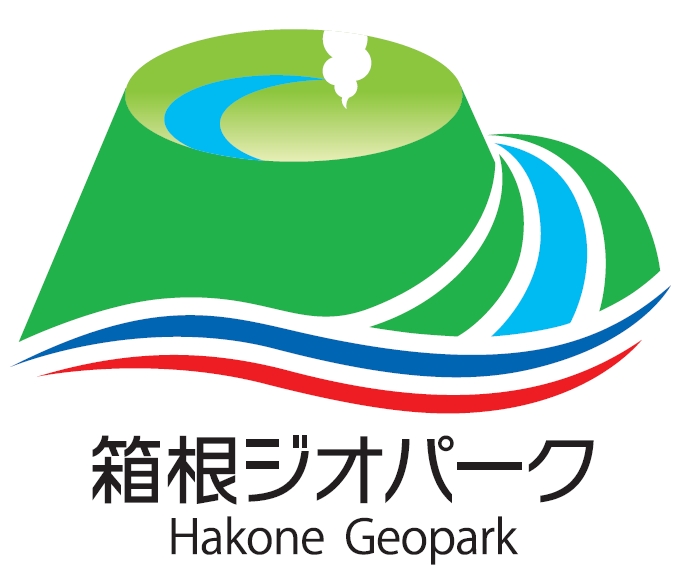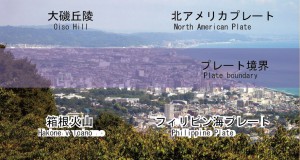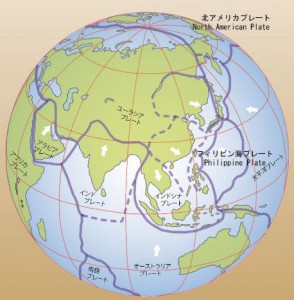Ishigakiyama-ichiya-jo Castle
Ichiya Castle is a historic site designated by the Japanese government. This stone wall castle was built on the outer ridge of the Hakone Volcano by Hideyoshi Toyotomi, who planned to attack the Odawara Hojo clan that had barricaded themselves inside Odawara-jo Castle. The stone walls of Ichiya Castle were different from those of Odawara-jo Castle. While arrow loops were created on the stone walls of Odawara-jo Castle, natural s paces created as a result of piling roughly crushed andesite rocks were used as arrow loops at Ichiya Castle. These andesite rocks were stacked by the Nozura Zumi piling method. A round stone wall called Ido Kuruwa and another stone wall of Mi nami Kuruwa situated in the south of the Castle together create spectacular views. From Ichiya Castle, you can see Ashig ara Plain, where Odawara city center is located, Oiso Hills, and the Kozu‒Matsuda fault belt that divides Ashigara Plain and Oiso Hills.
You can just see the plate boundary from here!
The earth’s surface is covered with tens of rock sheets called plates. One boundary passes close to this area. The Ichiya-jo Castle is situated on the Hakone Volcano and the Hakone Volcano belongs to the Philippine Sea Plate. The Oiso-kyoryo Hills belong to the North American Plate. There is a plate boundary between Hakone Volcano and Oiso-kyuryo Hills and the Oiso-kyuryo Hills side has been pushed up.
Plate tectonics map of Asia

Odawara Battle Offense and Defense Figure
In April of 1590, Odawara Hojo was the most powerful daimyo in the Kanto region. The stronghold of Odawara Hojo, Odawara-jo Castle, was surrounded by the massive armies of various daimyos led by the Kampaku (Adviser to the Emperor) Toyotomi Hideyoshi who was promoting unification of the entire country
The Battle of Odawara between Hojo and Toyotomi
Division of World (plate boundaries) Battle –
Then the Sengoku era ended.
During the course of this battle, not only the generals in the Kanto region but even Date Masamune and the generals of Tohoku pledged their allegiance to Hideyoshi. As a result, Hideyoshi achieved unification of the country. The Sengoku era ended along with the demise of Odawara Hojo.
Hideyoshi, Ishigakiyama-ichiya-jo Castle Fortification
Hideyoshi built the magnificent Ishigakiyama-Ichiya-jo Castle in order to capture Odawara-jo Castle. He prepared for a long battle equipped with sufficient troops and funds. Then after building Ichiya-jo Castle, Hideyoshi moved his headquarters from Yumoto Soun-ji Temple (Hakone Town) to Ichiya-jo Castle. Hideyoshi summoned Yododono (Hideyoshi’s concubine) and the wives of the participating generals to Ichiya-jo Castle. He also invited Tea Masters of Senno-rikyu and entertainers to bring comfort to the long encampment.
The Sengoku (Warring States) Heroes Surrounding Odawara-jo Castle
The army of Toyotomi on land and sea numbered approximately 220,000. Hideyoshi, with Tokugawa Ieyasu as the vanguard of his main force, invaded from Tokaido, while Maeda Toshiie and Uesugi Kagekatsu leading troops from the north country, invaded Hojo’s territory from Uenokoku (Gunma Prefecture). The navel forces led by Chosokabe Motochika and Kuki Yoshitaka, transported troops and supplies and engaged in a naval blockade. Odawara-jo Castle, which boasted the largest total structure in scale in the Middle Ages, was said to have held 60,000 people. Hojo at Odawara-jo Castle fought an offensive and defensive battle ranging over 3 months against famous Sengoku heroes such as Toyotomi Hideyoshi, Tokugawa Ieyasu, Oda Nobukatsu, Gamou Ujisato, Hashiba (Toyotomi) Hidetsugu, Ukita Hideie, Ikeda Terumasa, and Hori Hidemasa.
Odawara-jo Castle, the Largest Medieval Castle Appears
Odawara Hojo continued to negotiate with Toyotomi Hideyoshi who was approaching his homelands. At the same time, he fortified his castles beginning with Odawara-jo Castle and made preparations for general mobilization. Odawara Hojo constructed a massively lengthy structure of 9Km that surrounded the castle towns of Odawara-jo Castle and prepared for a decisive battle. Consequently, negotiations with Hideyoshi failed. Odawara Hojo fortified his borders and concentrated his main force in Odawara-jo Castle. Additionally, he reinforced the defense of his territory with auxiliary castles at over 100 locations.
The Surrender of Odawara Hojo
Odawara Hojo fought defensive battles at several castles around the country with a strategy to fight back when there was an opportunity. However, while Odawara-jo Castle that held his main forces was under siege, his auxiliary castles were defeated leaving him isolated. In July of the same year, Hojo Ujinao left the castle and offered to surrender. In exchange for his life, he requested that the lives of his family, his vassals, and the people held up in the castle be spared. Hideyoshi admired this action. He spared Ujinao’s life and banished him to Koyasan. However, Hideyoshi ordered Ujinao’s father, Ujimasa, and his brother, Ujiteru, to commit seppuku (suicide). This led to the demise of the Sengoku Daimyo Odawara Hojo clan.


